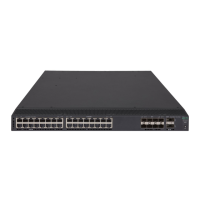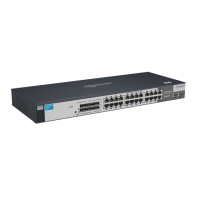54
• When an FCF switch assigns FC addresses to directly connected N_Ports, the FCF switch also adds
the direct routes of these addresses to the routing table. The direct route includes the following
settings:
{ The destination address is an assigned FC address.
{ The mask is 0xFFFFFF.
{ The outgoing interface is the VFC interface connected to the N_Port.
Static routes
Static routes are manually configured by the administrator. After you configure a static route, FC frames
to the destination specified in the static route are forwarded along the specified path.
In a simple network, static routes are enough for implementing network connectivity. By correctly setting
up and using static routes, you can improve network performance and guarantee bandwidth for critical
network applications.
Static routes cannot adapt to network topology changes. If a fault or a topological change occurs in the
network, the network administrator must modify the static routes manually.
Static routes support equal-cost routes. When you configure multiple equal-cost static routes to the same
destination but with different outgoing interfaces, equal-cost routes are generated.
FSPF routes
As a route selection protocol based on link states, FSPF can automatically calculate the best path
between any two switches in a fabric.
FSPF has the following characteristics:
• Can be used for any topology.
• Supports equal-cost routes.
• Performs topology calculations on a per-VSAN basis.
• Runs only on E_Ports and provides a loop-free topology.
• Provides a topology database on each switch to track the state of all links.
• Uses the Dijkstra algorithm to calculate routes.
• Provides fast convergence in the event of topology changes.
Basic concepts
• LSDB—The link state database (LSDB) stores global topology information for switches and link state
information of all switches in link state records (LSRs).
• LSR—An LSR describes information about all link states between a switch and its directly connected
switches.
Each LSR generated by a switch is called an LSR instance. LSRs generated by all switches comprise
the LSDB. An LSR contains all or part of the following link state information:
{ LSR hold time.
{ Domain ID of the switch advertising the LSR.
{ LSR instance number. Every time an LSR is updated, the instance number increments by 1.
